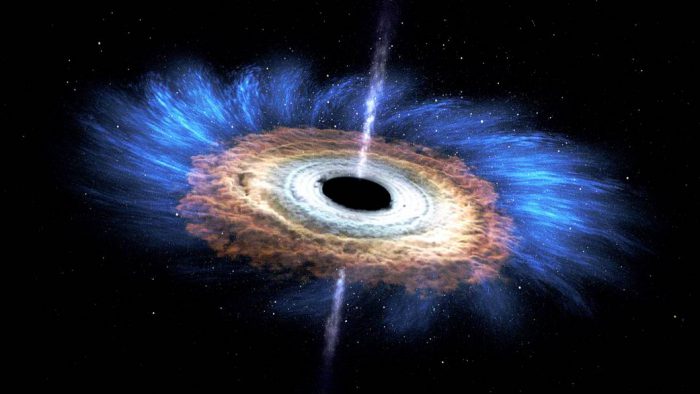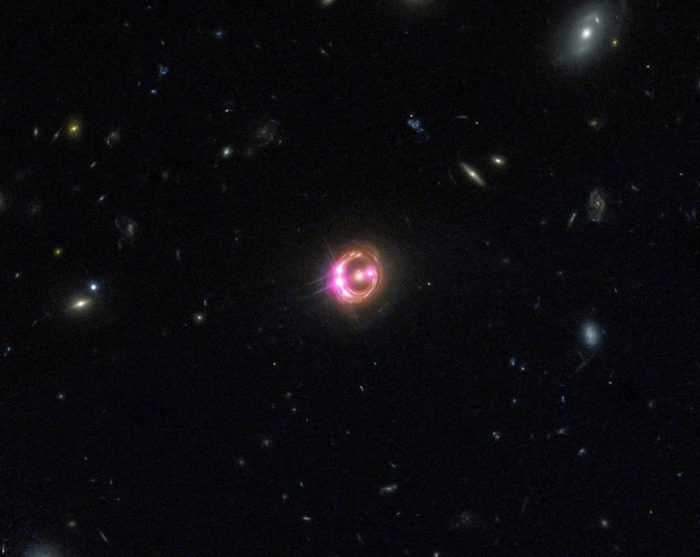Black holes have a fearsome reputation, but not all of these dense points of gravity are created equal. An average black hole, or stellar black hole, has about the same mass as 5 to 70 solar masses (or Earth suns).
While that is plenty large, supermassive black holes are absolute giants. They are between hundreds of thousands to even billions of solar masses. They tend to be at the centre of galaxies, where their massive gravity keeps it all together and spinning. For example, at the centre of our own Milky Way galaxy, you'll find a supermassive black hole that is 4.3 million solar masses.
No wonder it's called supermassive! But even that is a pygmy-sized piece of lint on the fabric of space time compared to a recent discovery by a group of Australian scientists. Get ready to meet the brilliant quasar found at the largest known black hole in the universe. (And whatever you do, be sure to stand back!)
Quite the quasar

The accretion disk is the spiral formed by a black hole feeding on stellar matter. In a supermassive black hole, the matter can travel half the speed of light and glow red hot, creating a quasar. (NASA's Goddard Space Flight Center)
A quasar is the term used to describe when the matter being collected by a black hole shines brightly like a star. In truth, it shines brighter than any star known. The intense friction and heat involved causes this matter to glow on its journey past the event horizon (a black hole's point of no return where not even light can escape). Quasars can end up being some of the brightest objects in the universe—in this particular case, we're talking about something that is especially bright by even quasar standards.
This supermassive black hole is larger than 20 billion solar masses—over 40,000 times bigger than the one at the centre of the Milky Way. In fact, if it was the one at the centre of our galaxy, it would shine 10 times brighter than a full moon. It would also release so much violent radiation in every direction that even at a distance of 28,000 light years from Earth, life here would be impossible. Yikes!
How did this happen?
Fortunately for us, this behemoth is a lot further away from us than that—about 12 billion light years away. Considering that it 'eats' a Sun-sized gulp of stellar matter every two days, we're not exactly interested in being neighbours!
But we are interested in knowing how a supermassive black hole of this size is possible. Because here's the thing—the light that we're seeing from this beast is 12 billion years old. (Yes, we're seeing deep into the past here!) Given that the entire universe was only around 1.6 billion years old at the time, scientists are amazed that it could have already grown to such an incredible size. (That's a lot of time spent at the all-you-can-eat solar buffet!)
Watch one of the lead scientists, astronomer Christian Wolf, talk about this and more to Australia's ABC News.
 This is an image of quasar RX J1131, which is about 6 billion years from Earth. The new quasar discovered by a team of Australian astronomers is twice as far away ... and much, much brighter. (X-ray: NASA/CXC/Univ of Michigan/R.C.Reis et al; Optical: NASA/STScI)
This is an image of quasar RX J1131, which is about 6 billion years from Earth. The new quasar discovered by a team of Australian astronomers is twice as far away ... and much, much brighter. (X-ray: NASA/CXC/Univ of Michigan/R.C.Reis et al; Optical: NASA/STScI)










how old is it ❓
yeah, how old is it? 😐
….